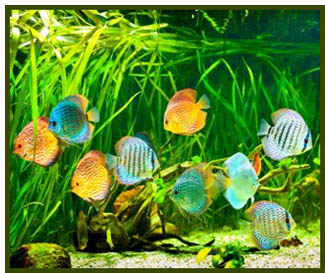How Many Fish Can You Put In Your Tank?
How many fish can you put in your aquarium? It is common to hear recommendations in terms of inches of fish per gallon of water. One inch of fish for every gallon of water is a common recommendation for freshwater aquariums. For saltwater, one inch of fish for every five gallons is recommended. Are these recommendations reasonable? Not really. Theyíre a decent starting point, but they donít take into account how well you are cleaning the aquarium and whether your fish have enough room to move and are not fighting for space.
Fish Need to Move
Fish need an aquarium that is large enough for them to freely move. If a fish is nearly as long as the tank is wide (
front to back), then the fish will barely be able to turn around. This can lead to long-term health problems for the fish. Having too many rocks and decorations can also constrain the movement of your fish. We recommend that the distance from the front to the back of the aquarium should be at least twice the length of any fish (
when it is fully grown).
Eels are an exception. They can be very long, but they often curl up their body. It isnít uncommon for a three-foot-long eel to be perfectly comfortable in an aquarium two feet wide. Some fish that can be difficult in home aquariums are rays, sharks, arrowana, large cichlids, and large plecostomus species. This is because they are large and like to swim a lot. Most of these fish require a larger footprint than standard aquariums have and will likely need a custom-built aquarium with enough width for them to easily swim.
To give fish more room to move:
1. Consider a flat and shallow aquarium rather than a tall and deep aquarium. Fish generally do not swim up and down--they move mostly horizontally.
2. Avoid large amounts of decorations in your aquarium. Leave plenty of open swimming space.
3. Consider the maximum size of every fish you add to ensure they will be able to move freely in the aquarium as they grow.
Fish Need Clean Water
The more fish and the bigger fish you have in an aquarium, the harder it is to maintain clean water. Dirty water with toxic ammonia and nitrate is harmful to fish and can result in an aquarium full of ugly algae. If your tank has algae or nutrient issues, stop adding fish.
What can you do to be able to have more fish?
1. Do frequent water changes
2. Use a bigger
skimmer or
filter
3. Clean the filter and change the cartridge more often
4. Increase the amount of water by using a
sump
5. Increase the bio-media (
live rock, bio balls, etc.)
6. Cultivate algae in a
refugium
7. Increase water flow with stronger
pumps (they will get more detritus into the filter/skimmer)
8. Use a
wavemaker (changing flow direction also helps with detritus)
9. Employ a
UV sterilizer to combat free floating algae
What products can you add to your system to make cleaning easier (
so you can safely have more fish)? A bigger and more efficient filter, skimmer, UV, refugium, and pump will help. Additionally, here are a few other considerations.
1. An
RO system in your home will give you a steady supply of clean water. Doing water changes will be easier if you have your own water supply
2.
Seachem De-nitrate 100 ml Bagged will reduce nitrates and phosphates
3. A quality water changer, gravel vac such as the
Python 25 ft. No Spill Clean & Fill will make water changes a breeze
Further Reading: Cleaning Basics 101: Six Pro Cleaning Tips
Fish Get Territorial
Even if all of your fish have room to swim, and their water is clean, you will have to stop adding fish at some point. Fish will get territorial and fight and kill any new fish added to the aquarium.
The best solution is to limit the fish in your aquarium, but if you will not be satisfied until your aquarium is crammed full of fish, here are three strategies for limiting aggression.
1. Pick peaceful, non-aggressive fish. Cichlids, triggerfish and tangs are known for being extremely territorial. If you do want to add these fish, try to add them as the last fish or add them all at once. If an aggressive fish has been in the tank for a long time, it may claim the entire tank as its own.
2. Using decorations and plants can also help limit aggression. It provides new fish a place to hide from aggressive fish and interrupts the line of sight between the aggressive fish and new fish. Too many rocks and decorations will take up swimming space, but a sensible amount is helpful.
3. Feeding your fish heavily can also limit aggression. Fat plump fish will not feel the need to aggressively compete with new fish for resources. Using an auto feeder to feed your fish in small amounts throughout the day is very helpful when trying to limit aggression. At
MarineAndReef.com we sometimes feed our fish 4-5 times a day specifically to limit aggression. But keep in mind--there is a tradeoff. More food means more waste and more waste means you will need more filtration.
If all else fails, get a bigger aquarium!!




























